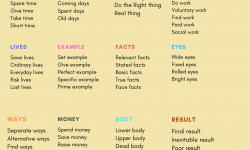Prepositions of Location At, In & On (PDF)
Prepositions show the relationship between a noun or a pronoun and some other element in a sentence or phrase. Prepositions may look like insignificant little words, but in reality they have very important functions. Prepositions are not simply little words that introduce a prepositional phrase such as ‘in the room’, ‘from the top floor’, ‘near the beach’, or ‘with mother’.

Prepositions of Location
Location can be thought of as the area, point, or surface of something. Certain prepositions indicate those locations. Here are some of the most commonly used ones:
along
among
at
behind
below
beside
between
in
in front of
in the middle of near
next to
on
over
under
with
Most of these prepositions make sense in the same sentence, because they all indicate location:
The boy is at the table.
The boy is behind the table.
The boy is beside the table.
The boy is next to the table.
The boy is under the table.
Besides the verb to be, which is frequently used to show location, there are several other verbs that also indicate where someone or something is:
to be found
to remain
to be located
to sit
to be situated
to stand
to lie
to stay
to live
Of course, there are many other such verbs. Those in the preceding list are among the ones used frequently. Look at these examples:
Is Turkey located in the east or west?
The center of the earthquake was situated near Istanbul.
Shells like this can be found along the banks of the river.
John sits in front of me.
The girl was lying on a cot and resting.
A stranger stood next to us.
I have to remain at my workbench until noon.
You can stay with me.
We live between two large houses.
As long as you know the meaning of the prepositions, you can use them with relative accuracy. But in English, just like in all other languages, certain prepositions can only be used with certain verbs or phrases. And even if two or more prepositions can be used with the same phrase, there is a change in meaning—even if it’s only a slight change.
Prepositions At & In
Let’s look at the prepositions at and in. They are used quite commonly and have a meaning that is easy to understand. In most cases, at is used to show that someone or something is positioned next to a horizontal or vertical surface:
at the table
at the door
at the computer
at the window
at the desk
at the blackboard
The preposition in indicates that someone or something is located inside something:
in the car
in the city
in the house
in the box
in the garden
in the center
These two prepositions, while having very distinct uses in a sentence, are also often used with the same phrases. But when they are, the meanings are different.
Use at to show that someone is at the location of his or her occupation, preoccupation, or some activity:
at school
at the store
at the hospital
at the movies
at the library
at the factory
With certain phrases, in can also be used:
in school
in the store
in the hospital
in the movies
in the library
in the factory
Notice the difference in meaning between the two prepositions:
Question: at school or in school?
at school= Someone is on the campus of the school, perhaps inside the building, or perhaps outside the building. This person is probably a student or teacher:
👉“The chemistry teacher was at school until 7:00 P.M.”
in school= Someone is inside the school building. This person is probably a student or teacher:
👉“The injured student was in school again today.”
Take note of yet another difference of meaning when the definite article the is added to the phrase:
at the school = Someone is on the campus of the school, perhaps inside the building, or perhaps outside the building. This person is not necessarily a student or teacher:
👉“The landscaper was at the school to plant some new shrubs.”
in the school = Someone is inside the school building. This person is not necessarily a student or teacher:
👉“My father was in the school for a meeting.”
There are several phrases that omit the definite article the when the preposition at is involved.
Such phrases indicate that someone is involved in the activity described in the phrase:
He’s at work. = He is working.
They’re at mosque. = They’re attending a religious ceremony.
The children are at play. = The children are playing.
She’s at home.= She is staying in her house.
Tom’s at lunch. = Tom is eating lunch. (also used with breakfast, dinner, and supper)
He’s at class. = He is attending a class.
In general, at indicates that someone is involved in an activity at a location. In says that someone is inside that location:
The students are at school. (They are on campus somewhere.)
The students are in school. (They are in the building in their classes.)
Father is at the hospital. (Father is visiting. Or he may be a doctor or nurse.)
Father is in the hospital. (Father is a patient. Or he was outside. Now he’s inside.)
Maria is at the factory. (She probably works there.)
Maria is in the factory. (She was outside. Now she’s inside.)
Mom is at the store. (She is shopping there. Or perhaps she works there.)
Mom is in the store. (She was outside. Now she’s inside.)
Question: Between or Among?
Be sure to distinguish between the prepositions among and between. Use among to say that you are in the company of more than just two people. Use between to say that you are in the company of only two people:
👉He sat among the members of the tribe and told them stories.
👉My sister sat between Jim and me.
Another pair of prepositions is often used to show “by means of what transportation” a person travels. It is common to use the preposition by to show the concept of traveling in a conveyance:
I went by car.
We travel by plane.
They go by train.
But in and on are also often used to show location on the forms of transportation:
We were in the car ready to leave for vacation.
They’re on a train somewhere in Oregon.
What bus were you on?
Haven’t you ever been on a plane before?
Preposition of Location PDF
Preposition of Location PDF – download



